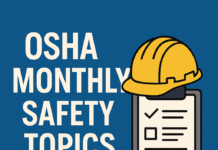
What Does OSHA Mean?
Introduction to OSHA
Occupational Safety and Health Administration, abbreviated as OSHA, stands as a cornerstone in ensuring workplace safety across various industries in the United States. Established to protect workers from hazardous conditions, OSHA plays a crucial role in maintaining safe working environments.
History of OSHA
The roots of OSHA can be traced back to the Occupational Safety and Health Act of 1970, signed into law by President Richard Nixon. This landmark legislation aimed to ensure safe and healthful working conditions for employees by setting and enforcing standards and providing training, outreach, education, and assistance.
OSHA’s Mission and Purpose
Ensuring Safe Working Conditions
OSHA’s primary mission is to prevent workplace injuries, illnesses, and fatalities by setting and enforcing standards that promote safe and healthful working conditions.
Enforcing Workplace Standards
OSHA is responsible for enforcing regulations that cover a wide range of industries, including manufacturing, construction, agriculture, maritime, and healthcare.
Key Responsibilities of OSHA
Setting and Enforcing Standards
OSHA establishes and enforces safety and health standards to ensure that employers provide their workers with safe and healthful workplaces.
Training, Outreach, and Education
In addition to enforcement, OSHA provides training, outreach, education, and assistance to employers and workers to help them understand and comply with workplace safety and health regulations.
Record-keeping and Reporting
OSHA requires employers to keep records of workplace injuries and illnesses and report them to the agency to track workplace safety trends and identify areas where intervention may be needed.
OSHA Regulations
General Industry Standards
OSHA’s general industry standards cover a wide range of workplace hazards, including exposure to chemicals, electrical hazards, machinery safety, and ergonomics.
Construction Industry Standards
For the construction industry, OSHA has specific standards that address hazards such as falls, trenching and excavation, scaffolding, and crane safety.
Agriculture Industry Standards
In the agriculture industry, OSHA regulates hazards related to farm machinery, pesticides, confined spaces, and grain handling.
OSHA Compliance
Employer Responsibilities
Employers are responsible for providing a safe and healthful workplace for their employees and complying with all applicable OSHA standards.
Employee Rights
Employees have the right to a safe workplace and can request an OSHA inspection if they believe that their employer is not providing a safe and healthful working environment.
Benefits of OSHA Compliance
Reduced Workplace Accidents
Compliance with OSHA standards can lead to a significant reduction in workplace accidents, injuries, and fatalities.
Improved Employee Morale
Employees feel valued and respected when their employer prioritizes their safety and health, leading to higher morale and job satisfaction.
Avoiding Penalties and Fines
Non-compliance with OSHA standards can result in penalties and fines, which can be costly for businesses and damage their reputation.
OSHA Inspections
How Inspections are Conducted
OSHA conducts inspections of workplaces to ensure compliance with safety and health standards. Inspections may be scheduled or unannounced, depending on the circumstances.
Common Violations
Common OSHA violations include failure to provide fall protection, inadequate hazard communication, lack of respiratory protection, and improper use of scaffolding.
Recent OSHA Developments
In recent years, OSHA has focused on emerging workplace hazards such as COVID-19, workplace violence, and ergonomic injuries.
Challenges Faced by OSHA
Budgetary Constraints
OSHA faces challenges in funding and staffing, which can affect its ability to effectively enforce workplace safety regulations.
Evolving Workplace Hazards
As workplaces evolve and new technologies emerge, OSHA must adapt its standards and regulations to address emerging hazards effectively.
Future Outlook for OSHA
Despite challenges, OSHA remains committed to its mission of ensuring safe and healthful working conditions for all workers and will continue to adapt and evolve to meet the changing needs of the workforce.
OSHA stands for the Occupational Safety and Health Administration. It's a federal agency in the United States that's responsible for ensuring safe and healthy working conditions for employees by setting and enforcing standards and providing training, outreach, education, and assistance.Conclusion
In conclusion, OSHA plays a vital role in protecting workers from hazardous conditions and ensuring safe and healthful working environments across various industries. By setting and enforcing standards, providing training and outreach, and conducting inspections, OSHA helps prevent workplace injuries, illnesses, and fatalities.
OSHA Exam Questions and Answers
List of OSHA Standards for Safety
Occupational Safety and Health Administration
FAQs
- What does OSHA stand for?
- OSHA stands for Occupational Safety and Health Administration.
- What is the purpose of OSHA?
- The purpose of OSHA is to ensure safe and healthful working conditions for employees by setting and enforcing standards and providing training, outreach, education, and assistance.
- How does OSHA enforce workplace safety?
- OSHA enforces workplace safety by conducting inspections, issuing citations for violations, and providing assistance and resources to employers and workers.
- What are some common OSHA violations?
- Common OSHA violations include failure to provide fall protection, inadequate hazard communication, lack of respiratory protection, and improper use of scaffolding.
- What are the benefits of OSHA compliance?
- Benefits of OSHA compliance include reduced workplace accidents, improved employee morale, and avoiding penalties and fines.





















